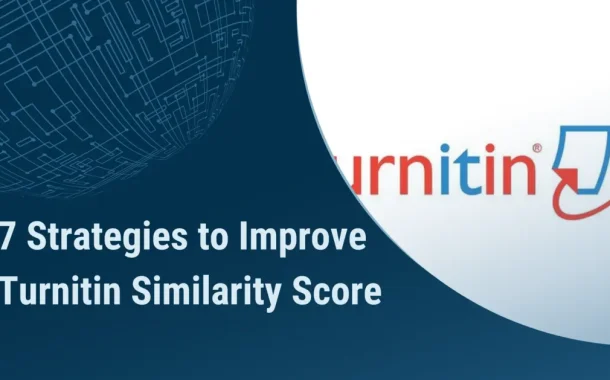Then, it gives you a report showing any matches it found and a score indicating how much of your work is similar to others. This helps teachers ensure students aren’t copying, and it teaches students about giving credit to others for their ideas.
Turnitin Similarity Score is important because it shows if your work is original or if it matches other sources. It helps students avoid plagiarism and teaches them how to give credit to others for their ideas. For teachers, it’s a tool to check students’ work and ensure fairness in grading.
Table of Contents
Table of Contents
What is the Turnitin similarity score
The Turnitin similarity score is like a grade that tells you how much of your work matches other sources. When you submit your essay or assignment to Turnitin, it compares your writing to millions of other documents, including websites, books, and papers. Then, it gives you a percentage, showing how similar your work is to these sources.
A higher percentage means more of your work matches other stuff, while a lower percentage means your work is more original. Turnitin breaks down your document into small parts and checks each part against its massive database. It highlights any areas that match with existing sources in an Originality Report.
This helps you see which parts might need better citation or paraphrasing. Teachers also use this score to check for plagiarism and ensure fairness in grading. Understanding your Turnitin similarity score is important because it helps you learn about academic integrity and how to properly credit others’ ideas in your work.
What is a good similarity score on Turnitin
A good similarity score on Turnitin typically falls below 10%, though this can vary depending on your school’s rules and the nature of your assignment. The score represents how much of your work matches existing sources in Turnitin’s database. A lower percentage suggests that your work is more original, while a higher one may indicate more significant overlap with other materials.
Remember, similarity scores don’t automatically mean you’ve plagiarized; they just show where your work aligns with existing content. Different factors, like the type of assignment and citation style, can affect your score. It’s crucial to check your school’s guidelines or ask your teacher what’s considered acceptable for your specific assignment.
Ultimately, understanding and aiming for a good similarity score reflects your commitment to academic integrity and proper citation practices, ensuring that your work is ethical and credible.
Strategies to Improve Similarity Score
Improving your Turnitin similarity score involves simple strategies to make your work more original.
Paraphrasing
Paraphrasing is a technique where you rewrite information from sources in your own words. Instead of copying sentences word for word, you express the same ideas using different language. This helps to make your writing more original and reduces the chances of matching existing sources in Turnitin. When paraphrasing, it’s essential to understand the original meaning of the text and express it accurately in your own words.
Avoid simply replacing words with synonyms; instead, focus on freshly conveying the same message. By mastering the skill of paraphrasing, you can effectively improve your Turnitin similarity score while still incorporating valuable information from your sources.
Proper Citation
Proper Citation is crucial in academic writing. When you use ideas, information, or phrases from other sources, it’s important to give credit to the original authors by citing them properly. This not only acknowledges the contributions of others but also helps to distinguish your ideas from those of others. By citing sources correctly, you demonstrate academic integrity and show respect for intellectual property rights.
Proper citation can help reduce your Turnitin similarity score by clearly indicating which parts of your work are borrowed from existing sources. Remember to follow the citation style specified by your instructor or institution, such as APA, MLA, or Chicago, to ensure consistency and accuracy in your citations.
Original Research
Original Research involves conducting your investigations and gathering new information or insights on a topic. By conducting original research, you contribute unique perspectives and findings to the academic discourse, making your work more original and reducing similarity with existing sources. This could involve conducting experiments, surveys, interviews, or analyzing data to generate new knowledge or interpretations.
Incorporating your original research into your writing demonstrates critical thinking skills and adds depth and credibility to your work. By including original research findings alongside existing sources, you can lower your Turnitin similarity score while enriching your writing with fresh perspectives and discoveries.
Synthesizing information
Synthesizing information entails bringing together ideas and concepts from multiple sources to create a cohesive and original argument or discussion. Instead of simply summarizing individual sources, synthesis involves analyzing and integrating information to form new insights or perspectives on a topic. By synthesizing information effectively, you demonstrate your ability to critically evaluate diverse sources and construct a nuanced understanding of the subject matter.
This process helps to reduce reliance on direct text matches with existing sources, thereby lowering your Turnitin similarity score. To synthesize information, carefully compare and contrast different viewpoints, identify common themes or patterns, and articulate your informed perspective based on the synthesis of sources.
Quotations Sparingly
Quotations Sparingly involves incorporating direct quotes from sources into your writing only when necessary. Direct quotes should be used to support your argument, provide evidence, or illustrate a specific point. However, overusing quotations can increase your Turnitin similarity score and detract from the originality of your work.
When including a direct quote, ensure that it is relevant, impactful, and adds value to your discussion. Additionally, always cite the source of the quotation properly to give credit to the original author. By using quotations sparingly and strategically, you can maintain the integrity of your writing.
Starting Early
Starting Early is a crucial strategy for improving your Turnitin similarity score. Beginning your work well in advance of the deadline allows you to conduct thorough research, plan your writing effectively, and take the time to craft original content. Rushing to complete assignments at the last minute increases the likelihood of unintentional plagiarism.
As there may be less time to properly paraphrase or synthesize information from sources. By starting early, you can work through the writing process at a comfortable pace, review and revise your work thoughtfully, and ensure that your final submission is both original and well-constructed.
Reviewing and Revising
Reviewing and revising your work is a crucial step in improving your Turnitin similarity score. After completing your initial draft, take the time to carefully review your writing for any unintentional matches with existing sources. Pay close attention to areas where you’ve paraphrased or summarized information from other texts, ensuring that you’ve expressed the ideas in your own words and cited the sources properly.
Additionally, consider the overall structure, coherence, and clarity of your writing, making revisions as needed to strengthen your argument and enhance the originality of your work. By thoroughly reviewing and revising your writing, you can identify and rectify any potential issues that may contribute to a high similarity score.
Addressing High Similarity Scores
Addressing high similarity scores on Turnitin requires a systematic approach to identify and potential issues contributing to the increased score.
- Review the Originality Report: Take the time to thoroughly examine the Originality Report provided by Turnitin. This report highlights specific areas of your document that match existing sources, along with the sources themselves. Understanding the sources contributing to the similarity score is crucial for determining appropriate corrective actions.
- Analyze and Compare Sources: Carefully analyze the content of your document alongside the matched sources identified in the Originality Report. Determine whether the similarities are the result of direct copying, inadequate paraphrasing, or citation errors. Compare the wording, structure, and ideas presented in both your work and the matched sources.
- Revise Problematic Areas: Identify the sections of your document with high similarity scores and revise them accordingly. Focus on incorporating original insights, rephrasing sentences, or adding additional analysis to differentiate your work from the matched sources. Ensure that all borrowed ideas are properly paraphrased and cited according to the required citation style.
- Seek Feedback: Seek feedback from your instructor, a writing tutor, or a peer to review your revised work. External feedback can provide valuable insights and suggestions for further revisions. Additionally, consider discussing any concerns or questions you have about reducing similarity scores with your instructor.
- Verify Turnitin Settings: Double-check the settings used for the Turnitin submission to ensure they are accurate. Confirm that any excluded materials, such as bibliographies, quotations, or reference lists, are appropriately accounted for. Adjusting these settings may help reduce the similarity score by excluding non-original content.
- Submit a Revised Version: Once you have made the necessary revisions, resubmit your document to Turnitin to generate a new Originality Report. Review the updated report to ensure that the similarity score has decreased and that any remaining matches are properly attributed to their sources.
Alternatives to Turnitin
Grammarly
Grammarly is a popular tool known for its grammar-checking features. It also includes a plagiarism detection feature, scanning your text against a vast database to find potential matches with existing content online. It’s user-friendly and widely used by students, professionals, and educators alike.
Copyscape
Copyscape is an online plagiarism checker primarily used to detect content duplication on the internet. It’s commonly used by website owners to ensure the originality of their online content. Copyscape offers both free and premium versions, allowing users to scan individual web pages or entire websites.
PlagScan
PlagScan is a comprehensive plagiarism detection tool used by educational institutions, businesses, and individuals. It scans documents against a large database of academic publications, internet sources, and proprietary content. PlagScan provides detailed reports highlighting any instances of plagiarism and offers customizable settings to meet specific needs.
Unicheck
Unicheck is a cloud-based plagiarism detection software designed for educational institutions and businesses. It offers real-time scanning of documents and provides detailed reports highlighting any instances of plagiarism. Unicheck integrates seamlessly with learning management systems and offers advanced features for detecting plagiarism in academic writing.
WriteCheck
WriteCheck, a service provided by Turnitin’s parent company, iParadigms LLC, offers standalone plagiarism checking. Users can submit their documents for plagiarism detection without having them stored in the Turnitin database. WriteCheck provides detailed reports and feedback to help users improve the originality of their work.
Urkund
Urkund is a plagiarism detection software widely used in educational institutions across Europe and other parts of the world. It integrates seamlessly with learning management systems and offers advanced features for detecting plagiarism in academic writing. Urkund provides detailed reports highlighting any instances of plagiarism and offers guidance on how to improve originality.
Viper
Viper is a free plagiarism checker that scans documents against a massive database of academic papers, journals, and internet sources. It provides detailed reports highlighting any instances of plagiarism and offers suggestions for improving originality. Viper is user-friendly and widely used by students and educators to ensure academic integrity.
Conclusion
The Turnitin similarity score is crucial for students and educators to maintain academic honesty. Throughout this article, we’ve learned why the similarity score matters and how to interpret it. By knowing what the score means, students can avoid unintentional plagiarism and learn to cite sources properly.
Educators can use it to teach about academic integrity and identify potential issues. Remember, a high similarity score doesn’t always mean plagiarism; it just shows where your work matches existing sources. By following the strategies discussed here, students can improve their scores and produce more original work. Turnitin is a helpful tool, but it’s important to remember that it’s just one part of maintaining academic integrity.














